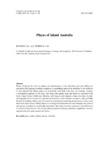Mostrar o rexistro simple do ítem
Playas of inland Australia
| dc.contributor.author | Bourne, J. A. | |
| dc.contributor.author | Twidale, C. R. | |
| dc.date.accessioned | 2011-11-18T12:31:19Z | |
| dc.date.available | 2011-11-18T12:31:19Z | |
| dc.date.issued | 2010 | |
| dc.identifier.citation | Cadernos do laboratorio xeolóxico de Laxe, 2010, 35: 71-97. ISSN: 0213-4497 | es_ES |
| dc.identifier.issn | 0213-4497 | |
| dc.identifier.uri | http://hdl.handle.net/2183/8380 | |
| dc.description.abstract | [Abstract] Playas, mostly in the form of salinas, are characteristic of the Australian arid zone. Many are associated with lunettes in sebkha complexes or assemblages and can be attributed to the deflation of bare alluvial flats. Many playas are structurally controlled. Lake Eyre, for example, occupies a downfaulted segment of the crust, and many other playas large and small are associated with faults. Lakes Frome, Callabonna, Blanche, and Gregory each displays a linear shoreline, but also and arguably, all are located on a regional structural arc. Lake Gairdner occupies a valley probably blocked by faulting. Others may be caused by preferential weathering along fracture zones, some linear but others arcuate. Many salinas are developed in dismembered rivers channels, the position and pattern of which are structurally determined. But many owe their existence to the interaction of several of these factors. The various salts precipitated in playas constitute a significant resource, regional and local, past, present and future. | |
| dc.language.iso | eng | es_ES |
| dc.publisher | Universidade da Coruña | es_ES |
| dc.subject | Playa | es_ES |
| dc.subject | Salina | es_ES |
| dc.subject | Sebkha | es_ES |
| dc.subject | Lunette | es_ES |
| dc.subject | Australia | es_ES |
| dc.title | Playas of inland Australia | es_ES |
| dc.type | info:eu-repo/semantics/article | es_ES |
| dc.rights.access | info:eu-repo/semantics/openAccess |






